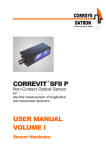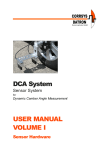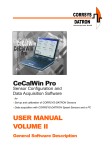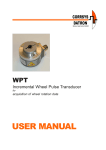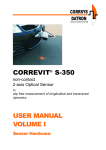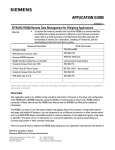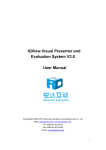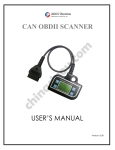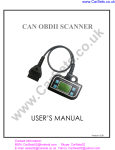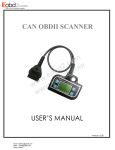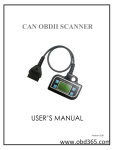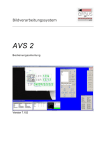Download CORREVIT LFII P USER MANUAL VOLUME I
Transcript
CORREVIT LFII P ® Non-Contact Optical Sensor for slip-free measurement of vehicle speed and distance USER MANUAL VOLUME I Sensor Hardware User Manual CORREVIT® LFII P Sensor Note: For a general description of the CeCalWin Pro Software please refer to the separate user manual Volume II. For the specific software description please refer to the separate user manual Volume III. © 2008 CORRSYS-DATRON Sensorsysteme GmbH, Wetzlar, Germany D061-50-01-04E 02/08 2 CORREVIT® LFII P Sensor User Manual VOLUME I - Sensor Hardware Table of Contents General Information . . . . . . . . . . . . . . . . . . . . . . . . . . . . . . . . . . . . . . . . . . . .4 Safety Instructions . . . . . . . . . . . . . . . . . . . . . . . . . . . . . . . . . . . . . . . . . . . . .5 1. Overview . . . . . . . . . . . . . . . . . . . . . . . . . . . . . . . . . . . . . . . . . . . . . . . . . .6 2. Extent of Delivery . . . . . . . . . . . . . . . . . . . . . . . . . . . . . . . . . . . . . . . . . .8 3. Technical Data . . . . . . . . . . . . . . . . . . . . . . . . . . . . . . . . . . . . . . . . . . . . .9 3.1 Specifications . . . . . . . . . . . . . . . . . . . . . . . . . . . . . . . . . . . . . . . . . . . .9 3.2 Pin Assignments . . . . . . . . . . . . . . . . . . . . . . . . . . . . . . . . . . . . . . . .10 3.2.1 PC (RS232) / CAN Outputs . . . . . . . . . . . . . . . . . . . . . . . . . .10 3.2.2 Power Connector Outputs . . . . . . . . . . . . . . . . . . . . . . . . . . . .10 3.2.3 Analog/Digital Outputs . . . . . . . . . . . . . . . . . . . . . . . . . . . . . .10 3.3 Internal Signal Filtering . . . . . . . . . . . . . . . . . . . . . . . . . . . . . . . . . . . .11 3.3.1 Filter Values for Speed and Slip Angle Output . . . . . . . . . . . . .11 3.3.2 Optional Acceleration Signal . . . . . . . . . . . . . . . . . . . . . . . . . .11 3.4 Typical Data Plots . . . . . . . . . . . . . . . . . . . . . . . . . . . . . . . . . . . . . . . .11 4. Set-up and Connection . . . . . . . . . . . . . . . . . . . . . . . . . . . . . . . . . . . .12 4.1 Mounting Options . . . . . . . . . . . . . . . . . . . . . . . . . . . . . . . . . . . . . . . .12 4.2 Sensor Mounting Jig . . . . . . . . . . . . . . . . . . . . . . . . . . . . . . . . . . . . .12 4.3 Mounting Instructions . . . . . . . . . . . . . . . . . . . . . . . . . . . . . . . . . . . . .13 4.3.1 Mounting with Suction Holders . . . . . . . . . . . . . . . . . . . . . . . .13 4.3.2 Mounting with Magnetic Plate Mounting Unit . . . . . . . . . . . . . .15 4.3.3 Wheel Mount Set-Up . . . . . . . . . . . . . . . . . . . . . . . . . . . . . . .18 4.4 5. Connecting the Sensor . . . . . . . . . . . . . . . . . . . . . . . . . . . . . . . . . . . .22 Troubleshooting . . . . . . . . . . . . . . . . . . . . . . . . . . . . . . . . . . . . . . . . . . .24 Appendix: - Technical Drawings CORREVIT® is a registered trademark of CORRSYS-DATRON Sensorsysteme GmbH, Wetzlar Germany. In a continuous effort to improve our products CORRSYS-DATRON reserves the right to change specifications without prior notice. © 2008 CORRSYS-DATRON Sensorsysteme GmbH, Wetzlar, Germany D061-50-01-04E 02/08 3 User Manual CORREVIT® LFII P Sensor General Information Legal Notice Information furnished is believed to be accurate and reliable. However, CORRSYS-DATRON assumes no responsibility for the consequences of use of such information nor for any infringement of patents or other rights of third parties which may result from its use. No license is granted by implication or otherwise under any patent or patent rights of CORRSYS-DATRON. Specifications mentioned in this publication are subject to change without notice and do not represent a commitment on the part of CORRSYS-DATRON. This publication supersedes and replaces all information previously supplied. All brand names are trademarks of their respective holders. Copyright ©Copyright 2007, CORRSYS-DATRON Revision D061-50-01-04E 02/08 Contact International Headquarters: CORRSYS-DATRON Sensorsysteme GmbH Charlotte-Bamberg-Str. 12 35578 Wetzlar / Germany Phone ++49 (6441) 9282-0 Hotline ++49 (6441) 9282-82 Fax ++49 (6441) 9282-17 E-mail [email protected] URL www.corrsys-datron.com North American Headquarters: CORRSYS-DATRON Sensorsystems, Inc. 21654 Melrose Avenue, Building 16 Southfield, MI 48075 / USA Phone ++1 (248) 204-0850 Toll-free++1 (800) 832-0732 Fax ++1 (248) 204-0864 E-mail [email protected] URL www.corrsys-datron.com China Headquarters: CORRSYS-DATRON Sensorsysteme GmbH, China Office Room 708, JinTianDi International Mansion, No. 998 RenMin Road, Shanghai (200021), P.R.China Tel.: ++86-21-63114144 Fax: ++86-21-63114154 E-mail: [email protected] URL: www.corrsys-datron.com.cn © 2008 CORRSYS-DATRON Sensorsysteme GmbH, Wetzlar, Germany D061-50-01-04E 02/08 4 CORREVIT® LFII P Sensor User Manual Safety Instructions Please read carefully before operating the equipment. CORRSYS-DATRON is not responsible for damage that may occur when this system is used in any way other than that for which it is intended. To assure safe and proper operation, all supplied equipment, components and/or accessories must be carefully transported and stored, as well as professionally installed and operated. Careful maintenance and usage in full accordance with operating instructions is imperative. CORRSYS-DATRON equipment should be installed and operated only by qualified persons who are familiar with devices of this type. Local regulations may not permit the operation of motor vehicles on public highways while the equipment is mounted on the exterior of the vehicle. • Use the equipment only for intended applications. Improper application is not advised. • Do not modify or change the equipment or its accessories in any way. • Improper use or mounting of the equipment may affect the safety of the vehicle and/or occupants. • The equipment must not be mounted and/or operated in any way that may compromise vehicle or and/or occupant safety. • Equipment must be mounted firmly and securely. • Use only original equipment, components and/or accessories included in the scope of delivery. • Do not mount equipment, components and/or accessories near heat sources (e.g. exhaust). • Do not use defective or damaged equipment, components and/or accessories . • Always note correct pin assignments and operating voltages when connecting equipment to power supplies, data acquisition/evaluation systems, and/or any other applicable system or component. Equipment may be damaged if not properly connected and/or operated. • For additional information, please call the CORRSYS-DATRON Hotline: ++49 (6441) 9282-82 or email: [email protected]. • Sensor head can become very hot and may cause injury if power has been applied to the sensor for extended periods of time. This is especially true if the sensor is used in hot environmental conditions. Danger • Invisible radiation from light emitting diodes! Do not observe with optical instruments. Laser class 1 M in compliance with DIN EN 60825 - 1:2001 • The sensor and/or sensor components may be damaged if power is applied for extended periods, especially in hot environmental conditions. Warning • Disconnect power from the sensor if the vehicle is stationary for extended periods. © 2008 CORRSYS-DATRON Sensorsysteme GmbH, Wetzlar, Germany D061-50-01-04E 02/08 5 CORREVIT® LFII P Sensor User Manual 1. Overview CORREVIT® LFII P Non-Contact Optical Sensor for slip-free measurement of vehicle speed and distance Art. No. LFII P Sensor 14395 The new CORREVIT® LFII P Optical Sensor represents yet another a major step forward in the advancement of optical measurement technology. Based on the Formula-1 proven CORREVIT® SF Sensor, the LFII P Sensor is even smaller and lighter than the compact SF model. The further miniaturization of the exceptionally lightweight LFII P Sensor enables mounting positions -such as under the vehicle - that were virtually unimaginable until now. Long-life, vibration-resistant infrared LED illumination and digital filters with advanced DSP technology provide improved performance, even under harsh environmental conditions. For connection to any current data acquisition system, the LFII P Sensor is equipped with analog (0...10V) and digital outputs, as well as CAN Bus, RS232, and USB for high-speed data transfer. A protective optical-glass lens prevents damage to the optics and the illumination source. The lens is optimized to the wavelength of the LED illumination source, and can be easily replaced without use of special tools. © 2008 CORRSYS-DATRON Sensorsysteme GmbH, Wetzlar, Germany D061-50-01-04E 02/08 6 CORREVIT® LFII P Sensor User Manual Features • Small and lightweight - just 250 g • Distance and speed measurement up to 250 kph • Adjustable filter time (unfiltered, 8 ... 512 ms) • Speed linearity - desired distance < ± 0.5 % Distance linearity < ± 0.2 % • Improved features by application of advanced DSP technology • Direct connection to PC or other evalutation systems • Illumination by long-life, high-power infrared LEDs • Signal outputs: analog 0 ...10 V digital 0-1000 pulses/m CAN Bus V2.0B USB 2.0 or RS232 • Negligible service and maintenance requirements as a result of durable technology • Tested and used under extreme environmental conditions Applications The compact CORRSYS-DATRON LFII P Sensor is designed for use in dynamic vehicle testing applications that require highly accurate measurement of the following variables: • Distance • Speed © 2008 CORRSYS-DATRON Sensorsysteme GmbH, Wetzlar, Germany D061-50-01-04E 02/08 7 CORREVIT® LFII P Sensor User Manual 2. Extent of Delivery 2. 1. 4. 9. 8. 5. 3. 6. 7. Standard delivery article no. 13996 1. 2. 3. 4. 5. 6. 7. 8. 9. (1) (1) (1) (1) Sensor head LFII P Sensor (Art.no. 14395) Electronic LFII / SFII (Art.no. 14269) Sensor cable 5m MIL #K 048-1D2-10-5 (Art.no. 13795) Power cable 2m SF, LF MIL 5P m bunch plug #K 042-24N-10-2 (Art.No. 13854) (1) RS-232 Output cable, 2m, MIL # K 042-160-22-2 (Art.no. 13682) (1) CAN Output cable, 2m #K 042-160-23-2 (Art.no. 13683) (1) Signal cable Analog-Digital 2m LF 13P MIL - 2x BNC #K 054-2D2-10-2 (Art.no. 14274) (1) Cooling element left + right #M 042-10-01-0- (Art.no. 14044) (1) USB Adapter (USB 2.0 to RS232 Converter - Art.no. 13971) Without illustration: (1) Transport case, T2 (Art.no. 11228) (1) Inlet for transport case (Art.no. 11127) (1) Inlet for transport case (Art.no. 11131) (1) Software CeCalWin (Art.no. 11343) © 2008 CORRSYS-DATRON Sensorsysteme GmbH, Wetzlar, Germany D061-50-01-04E 02/08 8 CORREVIT® LFII P Sensor User Manual 3. Technical Data 3.1 Specifications Performance Specifications Speed range: Distance resolution Uncertainty of measurement*: Speed linearity - desired distance Distance linearity Working distance and range: 0.3 ... 250 kph 2.08 mm < ±0.2% < ± 0.5 % < ± 0.2 % 200 +/-70 mm Outputs CAN Bus: CAN V2.0B - switchable terminating resistor (Intel or Motorola Format) 0...10V 1...1000 pulses/m USB 2.0 or RS232 ** Analog Output: Digitale Output: USB: System Specifications Power supply: Temperature range: operation: storage: rel. humidity: System Protection of the sensor head: Illumination: I Dimensions of the sensor head (l x w x h): Weight of sensor head: Dimensions of the electronics (l x w x h): Weight of the electronics: Shock: Vibration: 10,5 V ... 24 V; 28 W (12 VDC) -25 ... 50°C -40 ... 85°C 5 ... 80%, non condensing IP 67 R-LEDs, 850 nm, laser class 1M 100 x 33 x 45 mm (without plug) 250 g 130 x 86 x 33 mm approx. 490 g 50 g half-sine, 6 ms 10 g, 10 ... 150 Hz USB interface for connection to the PC, automatic sensor identification, function control. INVISIBLE RADIATION FROM LIGHT EMITTING DIODES! DO NOT OBSERVE WITH OPTICAL INSTRUMENTS LASER CLASS 1M IN COMPLIANCE WITH DIN EN 60825-1:2001 * with calibration on the test surface ** please choose when placing an order! © 2008 CORRSYS-DATRON Sensorsysteme GmbH, Wetzlar, Germany D061-50-01-04E 02/08 9 CORREVIT® LFII P Sensor User Manual 3.2 Pin Assignments 3.2.1 Pin Assignment: PC(RS 232) / CAN Outputs Cable: 5-pin MIL to 9-pin D-SUB - RS232: #K042-160-22-2m / CAN: #K042-160-23-2m RS-232-/CAN Pin 1: RXD Pin 2: TXD Pin 3: DGND Pin 4: CAN Low Pin 5: CAN High 3.2.2 Pin Assignment: Power Connector Cable: 5-pol. #K042-24N-10-2m Power Connector Pin 1: +12V Pin 2: +12V Pin 3: Case Pin 4: 0V Pin 5: 0V MIL connector 3.2.3 Pin Assignment: Analog- / Digital Outputs Cable: #K053-82D-10-2m Analog/Digital Pin 1: ANA_OUT3 Pin 2: ANA_OUT4 Pin 3: AGND Pin 4: DIG_OUT1 Pin 5: DIG_OUT2 Pin 6: DIG_OUT3 Pin 7: DIG_OUT4 Pin 8: AGND Pin 9: ANA_OUT1 Pin 10: ANA_OUT2 Pin 11: AGND Pin 12: DGND Pin 13: DGND © 2008 CORRSYS-DATRON Sensorsysteme GmbH, Wetzlar, Germany D061-50-01-04E 02/08 10 CORREVIT® LFII P Sensor User Manual 3.3 Internal Signal Filtering Signals may be smoothed using a moving average filter, which can be set to different time values. Note that signal detail and dynamics will decrease as the signal becomes decreasingly smooth. 3.3.1 Filter Values for Speed filter value • • • • • • • 8 ms 16 ms 32 ms 64 ms 128 ms (default setting) 256 ms 512 ms increased signal detail and dynamics (as well as noise) minimum signal delay smoothest signal maximum signal delay Use CeCalWin to change filter settings. 3.3.2 Optional Acceleration Signal The acceleration signal is calculated internally from the filtered speed signal. A shorter filter time will give a more noisy acceleration signal. The acceleration signal is additionally filtered with a 2s filter. 3.4 Typical Data Plots Brake test speed/acceleration © 2008 CORRSYS-DATRON Sensorsysteme GmbH, Wetzlar, Germany D061-50-01-04E 02/08 11 CORREVIT® LFII P Sensor User Manual 4. Set-up and Connection 4.1 Mounting Options 200 mm 200 mm longitudinal mounting only 200 mm Road surface The mounting distance from the lower surface of the sensor body to the road surface must be 200 ±70 mm. i Notice: In wet or snowy conditions, do not mount sensors in areas of excessive spray, i.e. directly behind the rear wheels. This will help to prevent measurement anomalies that can be caused by spray and/or blowing snow. 4.2 Sensor Mounting Jig Protection glass MTT00-10-35-PN 13 pin MIL connector Objective Lens Mounting holes LED Illumination For proper sensor mounting, use only M5 screws with a maximum thread engagement depth of 50 mm. Ideal length of screws is between 40 und 50 mm. © 2008 CORRSYS-DATRON Sensorsysteme GmbH, Wetzlar, Germany D061-50-01-04E 02/08 12 CORREVIT® LFII P Sensor User Manual 4.3 Mounting Instructions 4.3.1 Suction Mounting Unit 1. Pre-assemble the CORRSYS-DATRON Suction Mounting Unit (Art.No. 13990) as shown in Fig. 1.1. Fig. 1.1 2. Position the Suction Mounting Unit parallel to the vehicle body (e.g. at the driver-side door), as shown in Fig. 2.1. To assure proper function of the suction holders, the mounting area must be free of grease, oil, dust and other contaminants. For this reason it its necessary to clean the painted surface in the mounting area before attaching the suction holders. Do not use cleaning products that leave residue of any kind on the surface. Fig. 2.1 3. Adjust the Mounting Unit perpendicular to the ground: - Loosen the black levers at each suction holder so that the suction holder brackets slide freely. - Position the Mounting Unit so that is perpendicular to the ground (vertical). - Re-tighten both levers. bracket black lever Fig. 3.1b Fig. 3.1a © 2008 CORRSYS-DATRON Sensorsysteme GmbH, Wetzlar, Germany D061-50-01-04E 02/08 13 CORREVIT® LFII P Sensor User Manual 4. When the Mounting Unit is correctly positioned, press the suction holders - one after the other - firmly against the vehicle body to flatten the rubber pads against the body surface. Then, fold the grey levers toward suction holders to produce a vacuum, which will secure the suction holders to the vehicle body. When producing the vacuum, you will feel a distinct resistance. If the suction created is not sufficient to secure the holder(s), check to be certain that the mounting surface is clean. Always inspect the Suction Mounting Unit before use. Special attention should be paid to the condition of the rubber suction pads, which must be absolutely intact. Replace damaged pads immediately. Fig. 4.1 Use of a safety line is recommended. 5. Measure the sensor mounting height to be sure that the sensor is within the specified vertical operating range of 200 ±70 mm (see pages 9 and 12). This distance is measured from the bottom of the sensor body to the road or track surface. NOTE: The bottom of the heat sink/sensor mounting plate will be flush with the bottom surface of the sensor, so the mounting height can be measured from the bottom surface of the heat sink/sensor mounting plate. If the sensor is not within the specified vertical operating range, loosen the black levers at each suction holder and slide the vertical mounting rod up or down, as required, then re-tighten both levers. Fig. 5.1 If additional adjustment is required, fold the grey levers on the suction holders down to release suction, then remove the suction holders from the vehicle body by pulling the black tab on each holder. Reposition the Mounting Unit so that the mounting height is correct, then proceed with the mounting procedure described in Step 3 (page 12). 6. Insert the included sensor mounting screws through the mounting holes in the sensor, then into the mounting holes in the heat sink/mounting plate and tighten the screws. Fig. 6.1 © 2008 CORRSYS-DATRON Sensorsysteme GmbH, Wetzlar, Germany D061-50-01-04E 02/08 14 CORREVIT® LFII P Sensor User Manual 7. Connect the signal cable to the sensor. Fig. 7.1ba Fig. 7.1b 8. Route the signal cable trough the side window, into the interior of the vehicle and connect it to data acquisition, then secure the cable to the vertical mounting rod with with a cable tie. Fig. 8.1 4.3.2 Magnetic Plate Mounting Unit 1. Pre-assemble the CORRSYS-DATRON Magnetic Plate Mounting Unit (Art.No. 14091) as shown in Fig. 1.2. Fig. 1.2 © 2008 CORRSYS-DATRON Sensorsysteme GmbH, Wetzlar, Germany D061-50-01-04E 02/08 15 CORREVIT® LFII P Sensor User Manual 2. Position the Magnetic Mounting Unit parallel to the vehicle body (e.g. at the driver-side door), as shown in Fig. 2.2. The magnetic plates will automatically hold fast to the (metal) vehicle door/body panel. Fig. 2.2 3. Adjust the Mounting Unit perpendicular to the ground: - Loosen the black levers at each magnetic holder so that the magnetic holder brackets slide freely. - Position the Mounting Unit so that is perpendicular to the ground (vertical). - Re-tighten both levers. bracket black lever Abb. 3.2b Use of a safety line is recommended. Fig. 3.2a 4. Measure the sensor mounting height to be sure that the sensor is within the specified vertical operating range of 200 ± 70 mm (see pages 9 and 12). This distance is measured from the bottom of the sensor body to the road or track surface. NOTE: The bottom of the heat sink/sensor mounting plate will be flush with the bottom surface of the sensor, so the mounting height can be measured from the bottom surface of the heat sink/sensor mounting plate. If the sensor is not within the specified vertical operating range, loosen the black levers at each magnetic holder and slide the vertical mounting rod up or down, as required, then re-tighten both levers. If additional adjustment is required, release the magnetic plates by pulling them away from the vehicle with the black handles. Reposition the Mounting Unit so that the mounting height is correct, then proceed with the mounting procedure described above. Fig. 4.2 © 2008 CORRSYS-DATRON Sensorsysteme GmbH, Wetzlar, Germany D061-50-01-04E 02/08 16 CORREVIT® LFII P Sensor User Manual 6. Insert the included sensor mounting screws through the mounting holes in the sensor, then into the mounting holes in the heat sink/mounting plate and tighten the screws. Abb. 5.2 7. Connect the signal cable to the sensor. Abb. 6.2a Abb. 6.2b 8. Route the signal cable trough the side window, into the interior of the vehicle and connect it to data acquisition, then secure the cable to the vertical mounting rod with with a cable tie. Abb. 7.2 © 2008 CORRSYS-DATRON Sensorsysteme GmbH, Wetzlar, Germany D061-50-01-04E 02/08 17 CORREVIT® LFII P Sensor User Manual 4.3.3 Wheel Mount The CORRSYS-DATRON Wheel Mount System for CORREVIT® LF Sensors is designed to enable precision tire-slip measurement. The following mounting units are recommended. Sensor Wheel Mounting Unit (Art. No. 14178) consisting of: (1) Torsion rod with protective boot (1) Suction holder (1) Torsion rod mounting clamp (1) Mounting disk with mounting hub (6) Centering stars (1 each for 3-, 4- and 5-lug hubs (Art. No 11295, 11293, 11294) Mounting collets for various lug nut sizes: Standard dimensions: 17 mm, #10070 19 mm, #10071 21 mm, #10072 further on request 1. Remove hubcap or any covering over wheel nuts and clean dirt/debris from wheel nuts. 2. Place collets on wheel nuts. Fig. 1.3 3. Position the mounting disc and attach it loosely to collets with mounting bolts and washers. NOTE: The mounting disc has 3 sets of slots for proper alignment with 3-, 4-, and 5-lug configurations. Each set of slots is marked 3x, 4x or 5x, corresponding the number of lugs. Fig. 2.3 © 2008 CORRSYS-DATRON Sensorsysteme GmbH, Wetzlar, Germany D061-50-01-04E 02/08 18 CORREVIT® LFII P Sensor User Manual 4. Place the centering star tightly against the mounting disk and position the concave edges of the centering star against the washers on the mounting bolts, as shown. Then, turn the centering star until it is tight against all of the washers to ensure that the mounting disk is properly centered on the wheel. Fig. 3.3 5. Continue to hold the centering star tightly against the mounting washers and mounting disk, then tighten the mounting bolts in a cross pattern, using an allen wrench. Fig. 4.3 6. Using an allen wrench, loosen the set-screw at the bottom of the torsion rod retainer clamp and place the retainer clamp onto the mounting hub. NOTE: The set screw should not be tightened until the torsion rod is properly positioned, see Step 11. (page 20). torsion rod mounting hub retainer clamp set screw Fig. 5.3 7. Slip the protective boots over the lower and upper sections of the torsion rod. Then, fit the upper section of the torsion rod into the joiner at the top of the lower section of the torsion rod. Check the safety line to be sure it is secured to the torsion rod. A safety line should always be used to avoid damage or injury in the event that a suction holder separates from the vehicle body during the test drive. safety line protective boots Fig. 6.3 © 2008 CORRSYS-DATRON Sensorsysteme GmbH, Wetzlar, Germany D061-50-01-04E 02/08 19 CORREVIT® LFII P Sensor User Manual 8. To assure proper function of the suction holders, the mounting area must be free of grease, oil, dust and other contaminants. For this reason it its necessary to clean the painted surface in the mounting area before attaching the suction holders. Do not use cleaning products that leave residue of any kind on the surface. Place the suction holders firmly against the vehicle fender and latch the suction holder lock handles (latched position is approximately parallel to vehicle fender surface). When producing the vacuum, you will feel a distinct resistance Fig. 7.3 9. Tighten the set screws that secure the upper and lower sections of the torsion rods together, using an allen wrench. Fig. 8.3 10.If necessary, adjust the torsion rod so that it is parallel to the vehicle, then tighten the nut that secures the suction holder mounting to the torsion rod. Fig. 9.3 11. Tighten the retainer clamp set-screw with an allen wrench. Fig. 10.3 © 2008 CORRSYS-DATRON Sensorsysteme GmbH, Wetzlar, Germany D061-50-01-04E 02/08 20 CORREVIT® LFII P Sensor User Manual 12.Secure the safety line at a suitable location on the vehicle. Fig. 11.3 13.Loosen the sensor mounting retainer set screw with an allen wrench. Place the mounting plate onto the mounting hub and re-tighten the set-screw. Insert the included sensor mounting screws through the mounting holes in the sensor, then into the mounting holes in the mounting plate and tighten the screws. Fig. 12.3 14.Measure the sensor mounting height to be sure that the sensor is within the specified vertical operating range of 200 ± 70 mm (see pages 9 and 12). This distance is measured from the bottom of the sensor body to the road or track surface. If the sensor is not within the specified vertical operating range, first loosen the screws and move the sensor up or down, as required, in the channels on the mounting plate and measure again. If this adjustment is insufficient, remove the mounting plate from the retainer clamp using an allen wrench. Move the plate up or down as required and re-attach the plate to the mounting plate, then securely re-mount the sensor to the mounting plate. bottom of sensor Fig. 13.3 15.Connect the signal cable to the sensor, then wind the cable loosely around the torsion bar. WARNING: Be sure to leave enough slack in the cable to allow for full-lock steering changes, but use caution to assure that the cable is not wound Danger too loosely around the torsion bar. Under no circumstances should the cable be loose enough to touch the tire or to be pulled under the fender during testing. Either circumstance would inevitably result in damage to the equipment and could also cause an accident. Finally, connect the cable to data acquisition. Fig. 14.3 © 2008 CORRSYS-DATRON Sensorsysteme GmbH, Wetzlar, Germany D061-50-01-04E 02/08 21 CORREVIT® LFII P Sensor User Manual 16.If desired, mount the optional heat sink onto the sensor head using an allen wrench. Fig. 15.3 4.4 Connecting the sensor Sensor Connections Sensor Electronic Connections to Sensor Analog & Digital Output Connector CAN & RS232 Connector to Power Supply to Electronics Box Reverse Polarity Protection The electronic unit is equipped with reverse polarity protection. In the event that polarity is inverted, the unit will not be damaged but the power LED will illuminate red! Immediately disconnect power from the unit and correct the power supply connection. © 2008 CORRSYS-DATRON Sensorsysteme GmbH, Wetzlar, Germany D061-50-01-04E 02/08 22 User Manual CORREVIT® LFII P Sensor To connect the sensor to a PC or laptop for set-up and calibration with CeCalWin Software: 1. Connect the sensor signal output to the signal input on the electronics with the 5m Sensor to Electronics Box Cable (Art. No. 13795). 2. Connect the electronic to a PC operating CeCalWin Software via the RS232 Output Cable, 2m (Art. No. 13682) 3. Be sure that the individual switches on each power output circuit on the power distribution unit are in the "OFF" position. 4. Connect the supply cable from the electronics to a CORRSYS-DATRON power distribution box. 5. Start the vehicle engine and carefully connect the power distribution unit to the vehicle power supply. 6. Switch the distribution box power circuit ON to send power to the sensor electronics box(es). 7. The sensor is now ready for set-up and calibration with CeCalWin Software. See Using the CeCalWin Software Package for complete details. To connect the sensor to data acquisition: If the sensor is currently connected to PC for set-up/calibration: 1. Disconnect the RS232 Output Cable (Art. No. 13682) from the PC/laptop. NOTE: It is not necessary to power down the sensor/electronic before disconnecting or connecting the signal cable. 2. Connect the electronic to data acquisition: - for Serial connection, simply connect the RS232 Output Cable, 2m (Art. No. 13682) to the data acquisition system. or - for CAN connection, disconnect the RS232 Output Cable and connect the electronic to data acquisition via CAN Output Cable, 2m (Art. No. 13683). If the sensor is not already connected to PC for set-up/calibration: 1. Connect the sensor signal output to the signal input on the electronic with the 5m Sensor to Electronics Box Cable (Art. No. 13795). 2. Connect the electronic to data acquisition: - for CAN connection, use CAN Output Cable, 2m (Art. No. 13683) or - for Serial connection, use RS232 Output Cable, 2m (Art. No. 13682) 3. Be sure that the individual switches on each power output circuit on the power distribution unit are in the "OFF" position. 4. Connect the supply cable from the electronics to a CORRSYS-DATRON power distribution box. 5. Start the vehicle engine and carefully connect the power distribution unit to the vehicle power supply. 6. Switch the distribution box power circuit ON to send power to the sensor electronics box(es). © 2008 CORRSYS-DATRON Sensorsysteme GmbH, Wetzlar, Germany D061-50-01-04E 02/08 23 User Manual CORREVIT® LFII P Sensor 5. Troubleshooting When troubleshooting the CORREVIT® LFII P begin by checking the following: Cables and power supply • Check all connections to determine that each is complete and that the system is connected to a power supply that provides voltage output within the specified range. • Check to determine that the correct cables have been used for all connections. • The following problems can be caused by incorrect or incomplete cable connections and/or connection to incorrect power supply voltage: - Output signals are not available to data acquisition and/or connected PC. - A sensor will not go out of standstill mode with vehicle motion. Status LED’s on sensor electronic boxes • If all connections are correct and no faults are present, the green "ST" (standstill) LED will be illuminated. • If the Sensor is in Standstill and the "ST" LED is not illuminated, polarity has been reversed and must be corrected. Operating range If a sensor is mounted out of the recommended height range (standoff distance), it may not go out of standstill mode with vehicle motion, and no measurement signals will be output. Check and correct mounting as necessary. Sensor lens The sensor lens (located on the underside of the sensor housing) may occasionally become dirty, preventing proper operation. Check and clean the sensor lens regularly. Software If one or more output signals appear to be incorrect, the sensor may have been set-up incorrectly via CeCalWin Software. Check all relevant settings in CeCalWin: - Check calibration factor Environmental conditions The sensor may occasionally interpret heavy spray from snow or water as part of the road or track surface, producing unexplained spikes in the output signals and/or other anomalous measurement artifacts. Sensors should be mounted away from the heaviest spray areas, especially directly behind the rear wheels. Electromagnetic interference If the sensor starts to send output signals without vehicle motion, triggering may have been caused by excessive electromagnetic interference from the test vehicle. To correct this condition, reset the sensor by disconnecting from power and then re-connecting, or by switching power off and then back on at the power distribution box. If the condition persists, disconnect sensor from vehicle ground and isolate it at all mounting points. If none of the above recommendations provides a solution, you may wish to contact CORRSYS-DATRON. Before doing so, please be ready to supply the following: • A .ccw file saved from CeCalWin software to serve as an example of the problem or fault condition. • A list of all outputs that appear to be problematic, i.e. CAN, RS-232. • The serial numbers of all relevant components. © 2008 CORRSYS-DATRON Sensorsysteme GmbH, Wetzlar, Germany D061-50-01-04E 02/08 24 User Manual APPENDIX CORREVIT® LFII P Sensor L APPENDIX A: Technical Drawings © 2008 CORRSYS-DATRON Sensorsysteme GmbH, Wetzlar, Germany D061-50-01-04E 02/08

























